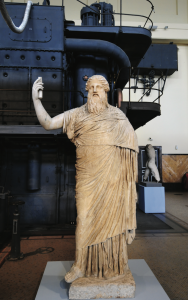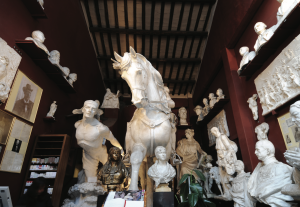If you’ve been to Rome once, then it’s time to go again. Marina Spironetti reveals ten things you should experience on your second visit to the Eternal City…

You have been to Rome. You survived the 7km or so of exhibits through the rather opulent Papal Rooms of the Vatican museums before being rewarded with a sensational view of Michelangelo’s Sistine Chapel. You have walked through the Rome of the Caesars, braving the heat of a summer day. You have explored the main sights of the centro storico – the imposing Pantheon, the Baroque Piazza Navona, the elegant Spanish Steps. You might have ticked off the essentials, but you are still a long way from really knowing (and understanding) this most entrancing of cities. In Rome there are so many obvious things to do that much is inevitably missed.
In order to fully appreciate the Città Eterna, you really need to come back and start discovering all those little gems that you could not fit in during your first city break. After all, you threw the customary coin into the Trevi Fountain, so you secured yourself a return visit… And while Rome wasn’t built in a day, it can’t be seen in a day either!
The ten tips that follow are far from being a comprehensive insider’s guide to Rome – even the locals agree that a lifetime is not enough to explore every nook and cranny. They simply aim to scratch a little deeper below the surface of this multi-faceted city and take you away from the usually overcrowded ‘must-see’ attractions and a bit closer to the ‘Rome of the Romans’.
Romes first power plant

Romes The Centrale Montemartini is doubtlessly one of Rome’s coolest museums. It started off as a temporary holding space back in 1997, following the restoration of a section of the Capitoline Museums. The excess of its collection of Roman sculptures and relics (including items that hadn’t been on display since the time of Mussolini) was relocated into this ex-thermoelectric power station (Rome’s first one, opened in 1912). Soon, the project proved so successful that it became a permanent fixture and a very welcome addition to the museum offerings of the Eternal City.
Once you step in, you can see why. You are greeted by some 400 classical statues standing against the dramatic backdrop of the power plant’s inky black iron machines. The contrast between ancient statuary and industrial archaeology, although bizarre, is memorable – even more so for a city like Rome, where juxtapositions of old and new are quite a rarity.
Works to look out for include the famous togato Barberini – a funerary statue of an aristocrat wearing a toga and displaying the busts of his ancestors – a fifth-century BC Aphrodite and a beautiful marble sculpture of the muse Polimnia.
This unique experience is even more atmospheric because of the museum’s peaceful emptiness – few tourists find their way here. Located in the Garbatella area, away from the crowds and the glitzy atmosphere of the centre, a visit to the Centrale Montemartini will offer you the added bonus of an insight into one of Rome’s working-class districts.
Bones along via Veneto

Via Veneto is usually synonymous with La Dolce Vita, with elegant cafés and 1950s American movie stars chased by the ever-present paparazzi. The hidden treat of this street, though, couldn’t be further removed from the sophisticated atmosphere that still permeates the area. The lovely church of Santa Maria della Concezione dei Cappuccini – better known as the Church of the Capuchins – hides a crypt where the friars are not buried, but ‘stored’. Four of its five chapels have been intricately decorated with the bones and grinning skulls of some 4,000 Capuchins, who died between 1528 and 1870. To transport the skeletons there, some 300 carts were used – the continuous procession of corpses must have caused some nightmares to the Romans who witnessed it!
The names of the chapels require no further explanation: Crypt of the Skulls, Crypt of the Pelvises, Crypt of the Tibia and Thigh bones, and Crypt of the Three Skeletons. Full skeletons dressed in traditional brown habit and grand chandeliers made of bones top off this gruesome attraction.
Listen to the people in front of a talking statue

If you walk by Piazza Navona, take a little detour to small Piazza Pasquino, west of the square. It takes its name from the battered marble torso there, whose base is covered with written complaints about the Pope, the Mayor of Rome, Berlusconi, politicians galore, and so on. Most of them rhyme and are written in a witty way. Italians have a reputation for protesting against the powers that be and Romans in particular are known for their rather sharp tongue. Pasquino is one of the so-called ‘talking statues’, a Roman tradition of street writing as a form of protest. To understand this bizarre phenomenon, you have to go back to the 16th century. In times where severe laws punished any form of criticism against the church, frustrated Romans began to use some statues as ‘post-it’ boards. To get round the extreme censorship laws, the anonymous messages – called pasquinate after the first person who wrote one – were posted overnight and circulated through the city the following day. For centuries this was the only form of mass media in Rome and it is still popular today.
Have a meal in canova’s workshop

These things can only happen in Rome. Only in a city overexposed to art can you stumble across an artist’s atelier that has been turned into an elegant café. The first impression is overwhelming. Having a cup of tea surrounded by two centuries of Italian statuary does not happen every day. Undoubtedly, the Museo Atelier Canova-Tadolini is one of Rome’s most atmospheric cafés. First used by sculptor Antonio Canova, the workshop passed through the hands of four generations of the Tadolini family – the first incumbent, Adamo, was Canova’s favourite pupil, and he inherited it from the great neoclassical maestro.
Waiters move elegantly among hundreds of plaster casts – of everything from monumental sculptures to studies of body parts – serving cookies, pastries and drinks. This would also be a good place for a light lunch. Before you go, don’t forget to have a look at the tiny studio on the ground floor, where the original tools can be admired. The only downside is the bill, which will be more expensive than your average café. Art has a price, after all.
A chocoholic paradise

In the heart of the San Lorenzo quarter sits an unexpected but magical world of chocolate – SAID dal 1923. The old chocolate factory is the capital’s oldest ‘cocoa workshop’. To find the still fully operational factory, walk along Via Tiburtina from Termini railway station, take the alley to your right once you arrive at where ‘No 13’ should be – there is no number! – and enter via a tiny door. You are finally in the enchanted kingdom of chocolate and will be rewarded with sweet and guilty pleasures of the food of the gods. The old factory still has a pleasantly old-fashioned atmosphere – beautiful furniture from the 1930s and old machines used for chocolate making when it first opened. Glass cabinets and trays scattered everywhere hold pralines, biscuits, sugared almonds and cakes; silver moulds hang on the wall like artwork.
La cioccolata is truly an art here – should you be curious to see how pralines, gianduiotti and other delicacies are made, look inside the open kitchen to watch the master chocolate makers in action. Sit down, relax and taste anything chocolatey your heart desires. Don’t forget to try a cup of cioccolata calda – the thick, not too sweet Italian hot chocolate. A true connoisseur’s delight.
